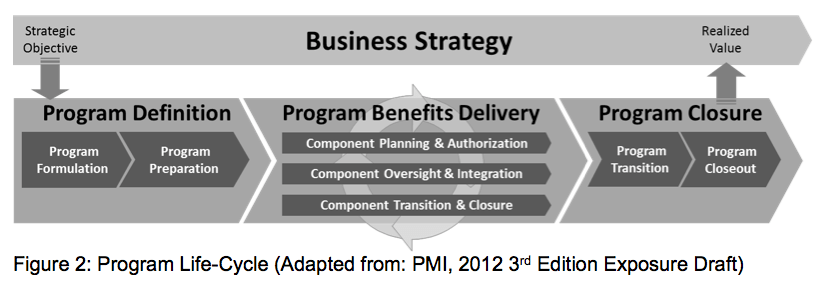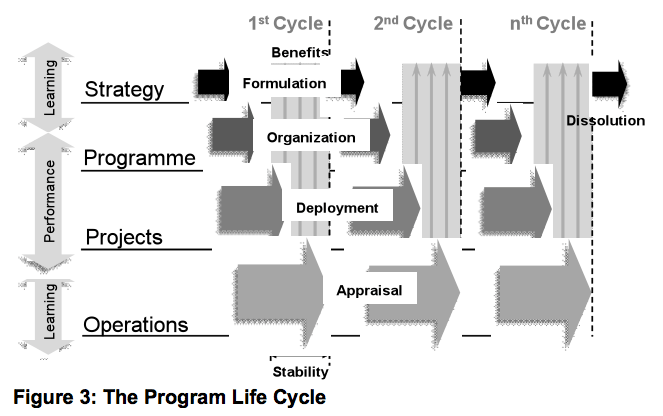Understanding the program management lifecycle
Most books and guides on program management written in the last 10 years have suggested program ‘phases’, which are simply transpositions of the project linear perspective. This view can jeopardise the effectiveness of program management and its capability to deliver strategies. Although it is now agreed that the objective of programs is to produce business level benefits by linking the strategy and projects, little management rhetoric has made its way into the program management literature and practice.
Recently, both the UK Office of Government Commerce (OGC) with Managing Successful Programmes and the Project Management Institute (PMI) with Standard for Program Management have aimed to clarify the lifecycle of the program and distinguish it from the project lifecycle. Below are diagrams that represent my own interpretation of the lifecycles that are described in these guides/standards.
In both cases the cycle concerns mostly the delivery of benefits where, as you go along, you could review objectives in regard to emergent inputs, what the PMI calls “adaptive change”.
On the other hand, current organisational best practice strategy is viewed as an ongoing process made of a series of choices aligned to a clear vision. A sound program management lifecycle should reflect this perspective and allow for feedback from the measure of benefits at operational level to the strategy itself. This type of program lifecycle can be summarised in five generic stages or processes:
- The Formulation stage, which consists of the definition of the program’s expected benefits through a stakeholder analysis and the agreement on the program purpose and objectives, which can include a functional blueprint. This process is iterative.
- The Organisation stage, which consists of the development of the program’s detailed business case and technical blueprint as well as operational procedures and structures. This process is iterative with the formulation.
- The Deployment stage, which consists of the delivery of capabilities through the program’s constituent projects and other actions, including the transition into the business. This is a cyclical process.
- The Appraisal stage, which consists of a program-level assessment of the benefits realisation and evaluation of the success of the transition to operational benefits. This is also a cyclical process.
- Finally, the Dissolution stage, which consists of the agreement on the timing and grounds for dissolution and implementation of the closing process, which includes long-term benefits measurement processes.
Importantly, the formulation of the program occurs at strategic level and involves the strategic actors and decision-makers. The organisation stage will involve the program team, including the governance team, and translate the business objectives into tangible program outcomes. During deployment, projects are initiated, planned and executed and other supporting activities are undertaken; project reviews, including approval of deliverables, take place during this stage.
Finally the program appraisal, based on the realisation of benefits, can only be made at operational level. The realisation of benefits is reported directly at the strategic level for approval to continue, or the decision to realign, suspend or stop the program.
The formulation and the strategy development part of the organisation stage are learning cycles, as is the appraisal of benefits realisation. These stages require the application of value management tools and techniques, as well as sense-making. The structuring part of the organisation stage as well as the management of projects in the deployment stage, are performance cycles where project management tools and techniques can be appropriately used.
The program lifecycle diagram above exhibits the cyclical nature of programs where benefits are appraised on a regular basis and the resulting operational outcomes are used to realign the strategy, if required. Typically the cycles of the program lifecycle also correspond to periods of stability that enable the organisation to absorb change at a rhythm that corresponds to its culture. These periods of stability, which usually correspond to stage gates, are typically determined when pacing the program.
Whether you are an executive, a sponsor, a user, a program or project manager, guides and standards can be useful, but it is your responsibility as a program stakeholder to understand what your role in a program is and how program management can help your organisation achieve its objectives.
Program management is the link between the business strategy and the value it will generate when implemented. It is the process through which executives will be able to express their needs and make sure they are fulfilled.
Sponsors will be able to define the improvements they are expecting and clearly link them to the strategy to ensure they are realized and aligned with the business objectives. Program managers will understand how to support both executives and sponsors in a tangible way and how to deliver measurable results to the business. Project managers will understand how their role is essential to the program’s success. Finally, operational and technical users will be able to make sure the expected improvements are well integrated and produce the expected results.




